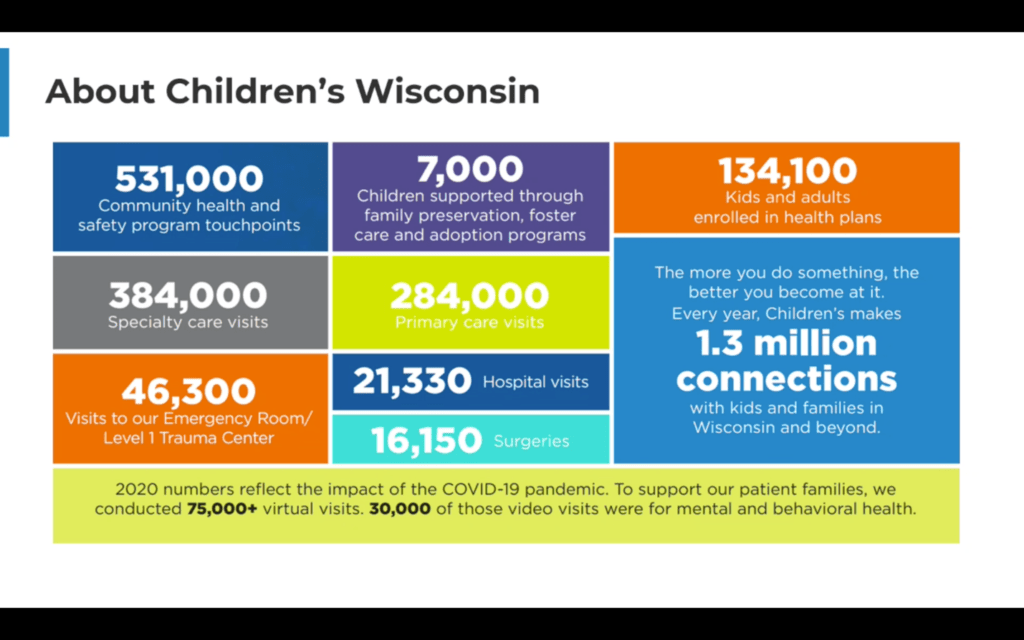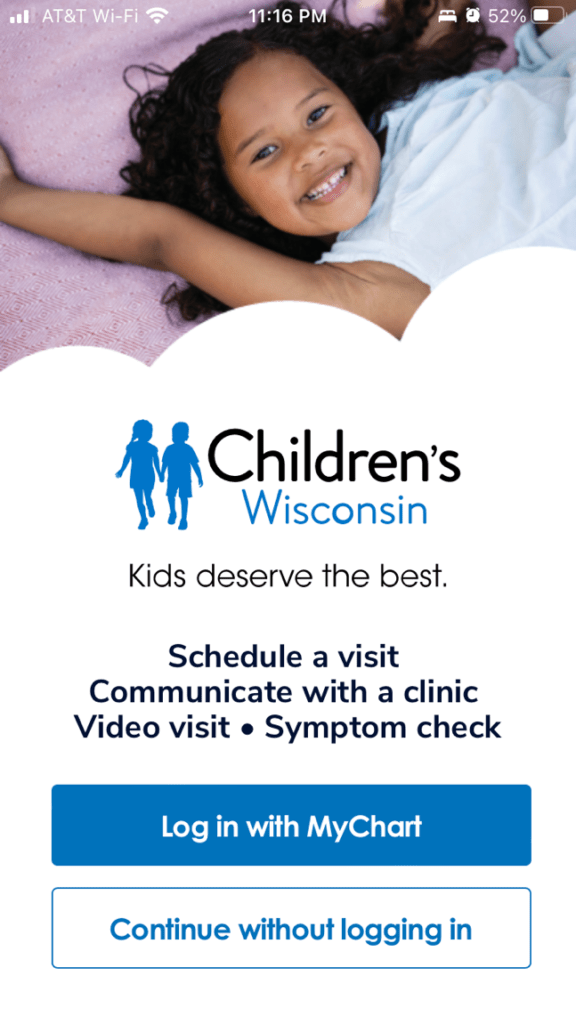Children’s Wisconsin App Makes Access to Care Easier for Families
// By Jane Weber Brubaker //

When a third of your families are MyChart power-users, you’d rock their world if you changed everything they’re familiar with. Instead, the Children’s Wisconsin branded app adds new features that parents want, built around the MyChart core.
If you have a sick kid, you need a quick, easy way to get answers to your questions about what to do. Should you go to the ER? Or is a virtual visit appropriate? Is urgent care the best option, or an office visit with your pediatrician?
Children’s Wisconsin wanted to give families a tool that would meet their needs for information and guidance and include features that would seamlessly integrate with Epic MyChart, technology the families already knew and used. The resulting app retains familiar MyChart features and adds much more functionality.
“MyChart is part of the experience. It looks and feels primarily like MyChart, but it is well integrated with the rest of the feature set in the application,” says Bryce Cannon, president at Modea. “You don’t have to log in or go somewhere separate to interact with MyChart as part of the experience.”
Christopher Neuharth is executive director of digital health and experience at Children’s Wisconsin. “We tried to minimize the amount of pain to our families from a change perspective,” he says.
Late last year Modea conducted proprietary research to better understand mobile consumers and how they engage with healthcare. The research confirms that the pandemic accelerated mobile health, especially among certain groups.
Here, we share some of the key findings from Modea’s research, and Neuharth explains some of the strategic decisions underpinning the design and development of the Children’s Wisconsin app. The results so far are promising.
Evolution of Mobile Health

Bryce Cannon, president at Modea
Modea’s research confirmed that the pandemic changed consumer behavior. The number of people using mobile devices to engage with healthcare increased. “Not totally surprisingly, we found that about a third of the respondents adopted new technologies, new apps since the advent of the pandemic,” says Cannon. “We also learned that almost 80 percent of the folks in that 33 percent chunk said they plan to continue using these tools.”
Among those who adopted new digital tools, one group stood out: millennial women, ranging in age from 26 to 41. “We learned that when we looked at female respondents specifically, the numbers are actually quite a bit higher, the usage goes up. They’re more frequently using mobile devices to manage healthcare,” says Cannon. “When we look at specific usage, adoption of these tools, that’s a really important group.”
Other survey questions examined consumer perceptions about patient portals, particularly the experience of accessing them using a mobile device. “We asked, what do you wish you could change, or what would you do in your patient portal if you could design it? What really comes through here is, I want ease of access. I want to be able to make an appointment. I want to be able to get the information that I’m looking for really quickly and easily,” Cannon explains.
He notes that some things consumers want aren’t part of the portal experience, such as symptom checking and data from wearable devices. With MyChart as the core or anchor of the mobile portal experience, other desired functionality can be integrated to add value for consumers.
Children’s Wisconsin App
Like many children’s hospitals, Children’s Wisconsin has a large subspecialty acute care hospital. Unlike others, it also has a large primary care base as well as a health plan. “We’re really looking holistically at a child’s health,” says Christopher Neuharth.

Children’s Wisconsin serves children and families through primary care as well as specialty care, and has its own health plan.
Parents often resort to the emergency room when they don’t know what else to do with a sick child. One of the goals for the app was to help divert some of that volume to more appropriate care settings. “How do we get all of these kids out of our emergency room that have low-acuity conditions? How do we get them to the urgent care or hopefully back to their pediatrician and organize that process?” Neuharth says.
What Do Families Want?
The first question Children’s Wisconsin needed to answer was, what do families really want? Journey mapping shows how fraught the experience of having a sick child can be. Here’s a typical set of actions a parent might take:
- Take temperature
- Monitor disposition
- Give Tylenol
- Ask questions of the child
- Google symptoms
- Discuss with partner
- Call Grandma
- Ask social network
- Call nurse friend
- Nurse triage line
- Make a reservation
- Arrange childcare
- And so on…
Parents’ greatest need is for guidance on how to react appropriately.

Christopher Neuharth, executive director of digital health and experience at Children’s Wisconsin
Neuharth explains, “As we evolved to what we wanted to do with our Children’s Wisconsin app, we said fundamentally, we want to make our family’s lives a little bit easier. We need to solve a problem for them in that consumer journey of how do I access your health system? How do I make sense of what to do in this moment?”
The app was co-designed with input from families. “We surveyed families, we completed job shadows in our clinics,” says Neuharth. “We also spent a lot of time interviewing parents — that’s where that journey mapping came in. Pre-COVID, we’d go in a home and sit for 60-90 minutes and [ask parents to] just explain your journey in that process.”
A branded app vs. Epic’s MyChart app made sense. In the Epic app, users have to wade through lots of other health systems to get to their own. “It’s just not a great way of really enhancing our brand and getting us out in the market, and we’re sort of subject to the whims of whatever Epic wants to do,” Neuharth says.
The Children’s Wisconsin app gets right to the point from the main screen. You can log in with MyChart, or continue without logging in. The main screen features four tasks:
- Schedule a visit
- Communicate with a clinic
- Video visit
- Symptom check

Many of the features of the Children’s Wisconsin app are available without logging in.
Without logging in, families can reserve a spot in a walk-in clinic, schedule an urgent-care video visit, or get information on the emergency room. Parents can consult the symptom checker, check dosage tables, and get first-aid advice.
The app allows you to tailor your experience by adding your child’s clinic or clinics as well as physicians. With this customization feature, one person’s app will look different from another’s.
By centralizing these features in one app, Children’s Wisconsin was able to consolidate several apps. “We shut down two or three different apps so far,” says Neuharth. “We had all these different apps and you just cannot ask families to go download one for video visits, another one for symptom checking.”
The app launched in mid-February. As of July, it had more than 5,000 active users, with 42,000 sessions. “More importantly,” Neuharth says, “almost 500 families have used the app to navigate to their same-day care options and in that time, we have tripled our urgent-care video visit volume year-over-year.” The app has maintained a five-star rating in the app store.
One app store user commented, “Impressive and functional. I like how you can keep track of your doctor’s offices and clinics all in one place! Also super helpful to be able to send texts within the app.”
Cannon recommends being strategic in getting a minimum viable product into the app store before the app is ready for a full launch. “At that point,” he says, “they’re just reviewing a version of your app and not the whole application itself and it goes much faster. It’s much simpler, and you’ve already worked out the kinks in that process.”
To justify the investment in extending the app beyond Epic’s feature set, Neuharth emphasizes to internal groups that the non-Epic features turn the app into a patient acquisition channel. “The more we’re providing symptom checkers and guiding you to our services, we’re getting you in there,” he says. “And we can show that data: This family had a first interaction on the app, and they established a primary care clinic as well.”
To ensure that the app is in fact making it easier for families and getting them the right care, Children’s Wisconsin tracks customer effort score, Net Promoter Score, CRM data, and clinical outcomes. “Are we actually making a difference for these families?” he asks. “Are we directing them to the right site of care? Are we getting the adoption in our urgent cares and lower cost sites of care as well?”
Six months of data post-launch suggests that the answer is yes.
This article is based on a presentation given at the Healthcare Marketing & Physician Strategies Summit (HMPS) in May.
Jane Weber Brubaker is executive editor of Plain-English Health Care, a division of Plain-English Media. She directs editorial content for eHealthcare Strategy & Trends and Strategic Health Care Marketing, and is past chair of the eHealthcare Leadership Awards. Email her at jane@plainenglishmedia.com.

